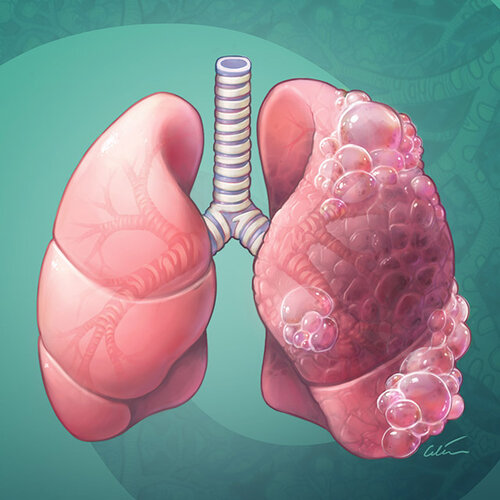
28 Jul Lung Disease: Causes and Treatments
Introduction
Welcome to our comprehensive guide on lung disease causes and treatments. In this article, we will delve into the intricacies of various lung diseases, their underlying causes, and the cutting-edge treatments available. Our goal is to equip you with the knowledge you need to make informed decisions about your respiratory health.
Understanding Lung Disease
Lung diseases are a diverse group of conditions affecting the respiratory system. They can range from common ailments like asthma and chronic bronchitis to more severe conditions such as lung cancer and pulmonary fibrosis. These diseases can impact the airways, lung tissue, or blood vessels, leading to difficulties in breathing and overall respiratory function.
Common Causes of Lung Disease

Tobacco Usage:
The prominent culprit behind preventable lung ailments is cigarette smoking. This habit exposes the lungs to detrimental toxins and irritants, significantly elevating the chances of chronic obstructive pulmonary disease (COPD), lung cancer, and various respiratory disorders.
Air Pollution:
Exposure to pollutants in the air, both indoors and outdoors, can contribute to the development and exacerbation of lung diseases. Fine particulate matter, vehicle emissions, and industrial pollutants can all have detrimental effects on lung health.
Genetics:
Some lung diseases, such as cystic fibrosis, have a genetic component. Inherited mutations can affect the production and function of proteins crucial for maintaining healthy lung function.
Occupational Hazards:
Individuals working in certain industries may be exposed to harmful substances like asbestos, coal dust, and silica, which can lead to occupational lung diseases.
Infections:
Respiratory infections caused by viruses, bacteria, or fungi can damage the lungs and trigger various lung diseases.
Types of Lung Diseases
Chronic Obstructive Pulmonary Disease (COPD):

COPD is a gradually advancing lung condition characterized by restricted airflow to the lungs. This disease encompasses emphysema and chronic bronchitis as its primary forms. Although smoking remains the leading cause of COPD, prolonged exposure to air pollutants can also contribute significantly to its development.
Asthma

Asthma is a chronic inflammatory disease that affects the airways, causing them to become narrow and swollen. This condition can be triggered by allergens, respiratory infections, exercise, or exposure to cold air.
Lung Cancer

Lung cancer is a serious and often fatal disease that develops when abnormal cells grow uncontrollably in the lungs. Smoking is the leading cause of lung cancer, but non-smokers can also develop this condition due to other risk factors like genetics and environmental exposures.
Pulmonary Fibrosis:

Pulmonary fibrosis is an advancing lung condition characterized by the formation of scar tissue and thickening of lung tissues. While the precise cause is frequently unclear, it can be triggered by exposure to environmental toxins, specific medications, or connective tissue disorders.
Pneumonia

Pneumonia is an infectious condition that leads to inflammation of the air sacs in one or both lungs. It can be attributed to bacteria, viruses, or fungi and may vary in severity, ranging from mild to severe, sometimes even posing life-threatening complications.
Diagnosing Lung Diseases

The accurate and timely diagnosis of lung diseases is crucial for effective treatment. If you experience persistent respiratory symptoms such as coughing, shortness of breath, or chest pain, it’s essential to consult a healthcare professional. Diagnosis often involves a combination of the following:
Medical History:
Your doctor will inquire about your symptoms, medical history, and any potential exposure to risk factors.
Physical Examination:
A thorough physical examination will be conducted to assess your lung function and overall health.
Chest X-rays or CT Scans:
Imaging tests help visualize the lungs and identify any abnormalities or signs of infection.
Pulmonary Function Tests (PFTs):
PFTs measure how well your lungs are functioning, assessing lung capacity and airflow.
Biopsies:
In some cases, a small tissue sample may be taken from the lungs for further analysis.
Managing Lung Diseases:

The approach to treating lung diseases varies according to the particular condition and its severity. While certain ailments respond well to medications and lifestyle adjustments, others necessitate more specialized interventions for effective management.
Medications
Medications are commonly prescribed to manage lung diseases and alleviate symptoms. Examples include:
Bronchodilators:
These medications help relax the airway muscles, making it easier to breathe for individuals with asthma and COPD.
Corticosteroids:
Anti-inflammatory drugs like corticosteroids can reduce airway inflammation in asthma and COPD.
Chemotherapy and Targeted Therapies:
These treatments are used for lung cancer patients to kill cancer cells or target specific molecules driving cancer growth.
Oxygen Therapy
For individuals with advanced lung diseases, oxygen therapy can be essential for improving blood oxygen levels and easing breathing difficulties.
Pulmonary Rehabilitation
Pulmonary rehabilitation programs provide a comprehensive approach to managing chronic lung diseases. They often include exercise training, breathing techniques, and education on managing symptoms.
Surgery
In some cases, surgery may be necessary to remove tumors (in lung cancer) or to improve lung function (lung volume reduction surgery for emphysema).
Lung Transplantation
For end-stage lung diseases, a lung transplant may be the only viable option for prolonging life and improving quality of life.
Conclusion
In conclusion, lung diseases are a complex group of conditions that can significantly impact an individual’s respiratory health. Understanding the causes and available treatments is essential for effective management and improved quality of life. If you or a loved one experiences any symptoms of lung disease, do not hesitate to seek medical attention promptly.





No Comments